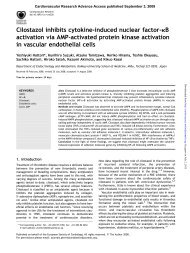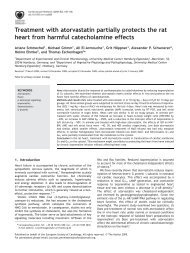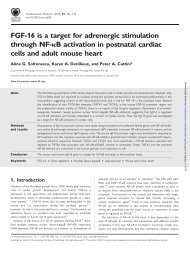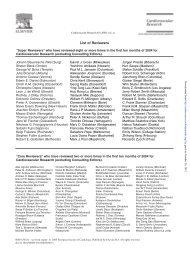The PGE2-Stat3 connection in cardiac hypertrophy - Cardiovascular ...
The PGE2-Stat3 connection in cardiac hypertrophy - Cardiovascular ...
The PGE2-Stat3 connection in cardiac hypertrophy - Cardiovascular ...
You also want an ePaper? Increase the reach of your titles
YUMPU automatically turns print PDFs into web optimized ePapers that Google loves.
4 M.C. Schaub, M.A. Hefti / <strong>Cardiovascular</strong> Research 73 (2007) 3–5<br />
Fig. 1. Simplified scheme of the major routes connected with PGE 2<br />
signal<strong>in</strong>g. PGE 2 is synthesized by enzymes on the nuclear envelope surface.<br />
<strong>The</strong> <strong>PGE2</strong> receptor subtype EP4 locates to the cell membrane and to the<br />
nuclear envelope. <strong>The</strong> EP4 receptor is able to couple with either Gs or Gi<br />
prote<strong>in</strong>s; when coupl<strong>in</strong>g to Gi, the heterodimeric Gβ/γ component is<br />
thought to activate the PI3K-PKB path [13]. <strong>The</strong> PI3K-dependent activation<br />
of the MEK-ERK pathway is not yet def<strong>in</strong>ed <strong>in</strong> detail. Angtg is<br />
<strong>in</strong>tracellularly transformed to AngII before secretion. <strong>The</strong> AngII receptor<br />
AT1 may signal via Gq as well as by direct <strong>in</strong>teraction with several adapter<br />
prote<strong>in</strong>s <strong>in</strong>clud<strong>in</strong>g β-arrest<strong>in</strong>, Src, and JAK. Both EP4 and AT1 receptors<br />
can transactivate the EGF receptor (a receptor tyros<strong>in</strong>e k<strong>in</strong>ase=RTK).<br />
ERK1/2 occurs <strong>in</strong> the cytosolic and nuclear fractions. <strong>The</strong> IL6-related<br />
cytok<strong>in</strong>es may be secreted and act <strong>in</strong> a paracr<strong>in</strong>e and autocr<strong>in</strong>e manner while<br />
<strong>PGE2</strong> may also act <strong>in</strong> an <strong>in</strong>tracr<strong>in</strong>e manner on the nuclear EP4 receptors. For<br />
full transcriptional activation <strong>Stat3</strong> requires phosphorylation at Tyr705 by<br />
JAK and at Ser727 by ERK. Abbreviations are <strong>in</strong> the text except for: DAG,<br />
diacylglycerol; GSK, glycogen synthase k<strong>in</strong>ase; iNOS, <strong>in</strong>ducible NO<br />
synthase; PI3K, phospho<strong>in</strong>ositide 3-k<strong>in</strong>ase.<br />
<strong>in</strong>hibitors and activators of these pathways. Furthermore,<br />
transfection of VNRC with small <strong>in</strong>terfer<strong>in</strong>g RNA (siRNA)<br />
specifically target<strong>in</strong>g the rat <strong>Stat3</strong> reduced expression of the<br />
latter by ∼70% and <strong>in</strong>hibited the hypertrophic reaction. <strong>The</strong><br />
requirement of 1 μM <strong>PGE2</strong> for elicit<strong>in</strong>g the hypertrophic<br />
reaction observed <strong>in</strong> VNRC seems rather high <strong>in</strong> view of the<br />
∼10,000-fold lower physiological plasma levels (60–<br />
110 pM) <strong>in</strong> the rat [7]. <strong>The</strong> authors may argue, however,<br />
that the <strong>in</strong>tracellular biosynthesis of PGE 2 could lead to<br />
significantly higher local concentrations than that found<br />
extracellularly <strong>in</strong> the plasma. Blockade of the delayed<br />
Tyr705 phosphorylation of <strong>Stat3</strong> by the transcription<br />
<strong>in</strong>hibitor act<strong>in</strong>omyc<strong>in</strong>-D as well as by the translation <strong>in</strong>hibitor<br />
cycloheximide [6] suggests that <strong>in</strong> VNRC stimulated by<br />
<strong>PGE2</strong> the phosphorylation of <strong>Stat3</strong> at Tyr705 is not the<br />
direct target of ERK1/2 although Ser727 of <strong>Stat3</strong> was<br />
shown to serve as substrate for ERK1/2 <strong>in</strong> other cell systems<br />
[2]. Bear<strong>in</strong>g <strong>in</strong> m<strong>in</strong>d that geniste<strong>in</strong> abolishes <strong>Stat3</strong><br />
phosphorylation, it seems that an as yet undef<strong>in</strong>ed<br />
<strong>in</strong>termediate tyros<strong>in</strong>e k<strong>in</strong>ase may orig<strong>in</strong>ate from de novo<br />
prote<strong>in</strong> synthesis. Obviously, the <strong>PGE2</strong> signal<strong>in</strong>g <strong>in</strong> VNRC<br />
between EP4 and MEK1/2 as well as between ERK1/2 and<br />
<strong>Stat3</strong> requires further exploration [6]. Here we tentatively<br />
review possible candidates <strong>in</strong>volved <strong>in</strong> knock<strong>in</strong>g on<br />
Stats' door.<br />
3. <strong>The</strong> JAK/Stat pathway<br />
Most hypertrophic stimuli such as stretch, angiotens<strong>in</strong>-II<br />
(AngII), IL6, CT1, and LIF activate the latent cytoplasmic<br />
transcription factors Stat1 and <strong>Stat3</strong>. Downregulation of<br />
<strong>Stat3</strong> is associated with end-stage heart failure, and its<br />
activation promotes cardiomyocyte survival and <strong>hypertrophy</strong>,<br />
while Stat1 correlates with pro-<strong>in</strong>flammatory responses<br />
and apoptosis [8,9]. In the canonical JAK/Stat signal<strong>in</strong>g<br />
pathway, b<strong>in</strong>d<strong>in</strong>g of the IL6-related cytok<strong>in</strong>es <strong>in</strong>duces<br />
dimerization of their receptors (gp130 and LIFR) and<br />
tyros<strong>in</strong>e phosphorylation <strong>in</strong> the cytoplasmic doma<strong>in</strong> by the<br />
receptor-associated tyros<strong>in</strong>e JAK1/2 k<strong>in</strong>ases for recruitment<br />
of specific Stats from the cytoplasm. After phosphorylation<br />
of Stat1 at Tyr701 and <strong>Stat3</strong> at Tyr705, they dimerize (homoor<br />
heterodimers) and translocate to the cell nucleus where<br />
they associate with the transcription mach<strong>in</strong>ery (Fig. 1). For<br />
full transcriptional activity Stat1 and <strong>Stat3</strong> require additional<br />
phosphorylation of Ser727 <strong>in</strong> the transactivation doma<strong>in</strong>,<br />
which represents a recognition site for ERK1/2, p38 MAPK,<br />
and other yet to be def<strong>in</strong>ed ser<strong>in</strong>e k<strong>in</strong>ases [12]. In isolated<br />
mouse hearts rapid phosphorylation of Ser727 of Stat1/3 was<br />
observed result<strong>in</strong>g from the signal<strong>in</strong>g cascade PKCε-Raf1-<br />
MEK1/2-ERK1/2 [10].<br />
4. How may <strong>Stat3</strong> be <strong>in</strong>tegrated <strong>in</strong>to <strong>PGE2</strong> signal<strong>in</strong>g for<br />
<strong>cardiac</strong> <strong>hypertrophy</strong>?<br />
In the nucleus <strong>Stat3</strong> stimulates the COX2 gene and COX2<br />
prote<strong>in</strong> expression, and the result<strong>in</strong>g <strong>in</strong>crease <strong>in</strong> PGE 2 levels<br />
further stimulates expression of COX2 <strong>in</strong> a positive feedback<br />
loop (Fig. 1). This feedback loop may not only operate <strong>in</strong><br />
paracr<strong>in</strong>e or autocr<strong>in</strong>e but also <strong>in</strong> the <strong>in</strong>tracr<strong>in</strong>e mode s<strong>in</strong>ce<br />
both COX2 and the <strong>PGE2</strong> receptor EP4 locate primarily to<br />
the nuclear envelope [3,5]. <strong>Stat3</strong> is also known to enhance<br />
expression of the angiotens<strong>in</strong>ogen (Angtg) gene and<br />
subsequent generation of AngII [11,12]. AngII <strong>in</strong>duces the<br />
release of the IL6-related cytok<strong>in</strong>es (IL6, CT1, LIF), which,<br />
<strong>in</strong> turn, activate the canonical JAK/Stat signal<strong>in</strong>g cascade<br />
lead<strong>in</strong>g to delayed tyros<strong>in</strong>e phosphorylation of <strong>Stat3</strong>, thus<br />
establish<strong>in</strong>g an autocr<strong>in</strong>e/paracr<strong>in</strong>e loop (Fig. 1). AngII<strong>in</strong>duced<br />
<strong>hypertrophy</strong> is thought to primarily depend on the<br />
activation of its Gq-coupled receptor (AT1). However, the<br />
AT1 receptor is also able to activate several additional<br />
downstream signal<strong>in</strong>g molecules <strong>in</strong>clud<strong>in</strong>g the Src family<br />
prote<strong>in</strong> tyros<strong>in</strong>e k<strong>in</strong>ases and ERK1/2 through G-prote<strong>in</strong><strong>in</strong>dependent<br />
mechanisms [13]. In particular, AT1 may<br />
directly <strong>in</strong>teract with JAK2, the SHP2 tyros<strong>in</strong>e phosphatase,<br />
phospholipase-C (PLC), and other prote<strong>in</strong>s serv<strong>in</strong>g as<br />
signal<strong>in</strong>g adapters and scaffold components. Furthermore,<br />
both AT1 and EP4 are reported to transactivate the EGFR,<br />
which may also signal via the ERK1/2 pathway (Fig. 1).<br />
Thus, multiple signal<strong>in</strong>g tracks jo<strong>in</strong> the MEK-ERK pathway,<br />
Downloaded from<br />
http://cardiovascres.oxfordjournals.org/<br />
by guest on March 25, 2013









